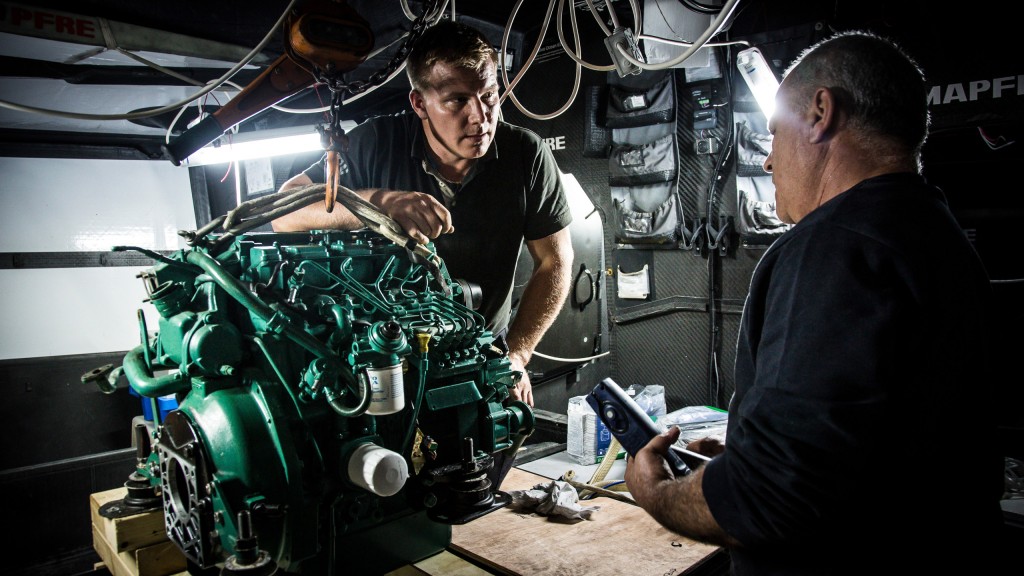Volvo Penta to power around-the-world race once again

For the sixth time, Volvo Penta - known for its engines in a variety of industrial, power generation and marine uses - is an official supplier to the Volvo Ocean Race, providing each of the Volvo Ocean 65 sailing boats with a D2-75 engine with Saildrive, hands-on engine maintenance and support, as well as additional power during the race stopovers.
Designed for the toughest of conditions, the Volvo Penta D2-75 engines have already done one lap around the world, covering approximately 39,000 nautical miles during the 2014-15 Volvo Ocean Race. Thanks to having one boat design for two race editions, the Volvo Ocean 65 boats and Volvo Penta engines from 2014-15 will race around the world for a second lap of 46,000 nautical miles, once again prepared to meet some of the toughest challenges in round-the-world sailing.
The Volvo Ocean 65 boats often operate at high speeds, where extreme maneuverability is critical in all conditions. "The conditions of the Volvo Ocean Race are extreme and not only push the boats and sailing crew to the limit, but, also, all the equipment," commented Mark Turner, CEO of the Volvo Ocean Race. "We need to ensure everything onboard is 100% reliable. Volvo Penta provides the perfect engines to suit these extreme conditions.
"These boats have been built for two editions of the race and we have so much faith in the condition of the engines that we have not replaced them; we are confident they are up for a second trip around the world."
Reliable power source at sea
Each of the Volvo Ocean 65 boats will be equipped with one D2-75 engine for both auxiliary and propulsion needs. The engine is there when needed as a primary propulsion source - for safe navigation in and out of harbors, as well as a potential lifesaving instrument in case of an emergency.
During the actual race, the gearboxes are sealed, but the engine is used to power the boats' total demand for electricity for computers, navigation equipment, lights and communication units onboard. Additionally, the engine onboard provides power to the batteries to run the water maker, which converts salt water into drinking water. The engine delivers the onboard energy required through two, 24 volt alternators, which stores the energy in two lithium Ion batteries.
It also supplies the power to the hydraulic system for the canting keel. The canting keel, which provides extra counterweight when sailing, is moved by hydraulic cylinders which are powered by an engine-driven, hydraulic pump.
"As a unique aspect for the Volvo Ocean Race, there are high energy requirements to provide power to laptops, camera and other media equipment, enabling the sailing teams to communicate directly from out at sea to the rest of the world," says Nick Bice, head of the boatyard for the Volvo Ocean Race.
"The engine is critical 100% of the time. It is the main source of power onboard, which converts energy for which the teams rely upon to survive. They depend on the engine to deliver drinking water, which is essential when the teams are sailing for weeks at a time."
An expanded supplier role
However, Volvo Penta supplies more than just the engine onboard. Hands-on technical expertise is available to the race organization and sailing teams through Volvo Penta engineer, Johannes Karlsson. Johannes will deliver full-time support for the duration of the event, traveling to each race stopover to deliver world-class engine support through The Boatyard. He is backed by the expertise of Volvo Penta's global dealer network, on-call to support as needed.
The Boatyard is a one-stop-shop to ensure all the Volvo Ocean 65s have access to the same level of maintenance and repairs after each leg of the race. Johannes brings a wealth of expertise, with over 16 years as a marine engineer and a strong love of boating.
"The philosophy in The Boatyard is to ensure all boats are serviced to the same level,' says Nick Bice. "This includes the engine. Our service staff consists of true experts in their respective fields, securing world-class service levels to support all equipment onboard."
Volvo Penta is also providing its next generation of gasoline sterndrive engines and complete prop to helm equipment for new RIB boats that will be used by the sailing teams at each city where the race stops around the world. The V6 280 model has been provided, delivering the cleanest engines available on the market in the gasoline segment to the sailing teams.
"In early tests, the Volvo Penta gasoline engines have surpassed our expectations from a performance perspective," says Nick Bice. "This includes outstanding results when it comes to safe and predictable handling, speed, acceleration, and fuel efficiency, as well as extreme ease of operation thanks to the Glass Cockpit System."
Additionally, Volvo Penta is delivering power generation for the newly designed Volvo Pavilion at each stop-over around the world, providing prime power to support business operations, guest hospitality, and the high-tech environment inside. This same technology is used every day to deliver power to people and society around the world.
"Volvo Penta is proud supplier to the Volvo Ocean Race providing solutions from both our marine and industrial product portfolios," says Björn Ingemanson, president of Volvo Penta. "We use existing, leading technology, available on the market today for our customers, depending on it to work in the toughest of environments - the world's most extreme sailing competition."
"The sailors are truly pushing new boundaries with the boats and all equipment onboard. We know that our customers are also interested in pushing boundaries in their respective industries. We learn from this experience to ensure the ultimate performance of our products in every day application."


